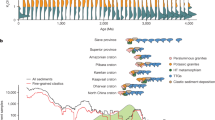Abstract
The first vent fluid samples recovered from submarine hydrother-mal systems on the Galapagos Rift1 and at 21° N on the East Pacific Rise (EPR)2 had a nearly identical ratio of 3He/heat of ~0.5 x l0−12cm3STPcar−1, even though the two hydrothermal systems were separated geographically and had widely differing fluid exit temperatures (~20 and ~350 °C, respectively)3–5. Jenkins et al.3 combined this ratio with independent estimates of the flux of mantle 3He through the oceans6, to calculate a global oceanic hydrothermal heat flux of 4.9 x 1019cal yr−1, which is in excellent agreement with geophysical estimates for this flux7,8. Other investigators then combined this 3He flux with measured ratios of various chemicals in vent fluids to 3He (such as Mn/3He and Si/3He) to estimate global hydrothermal fluxes for these species1,9,10. Here we show that 3He/heat ratios vary by over an order of magnitude between submarine hydrothermal systems, suggesting that early measurements of the 3He/heat relation are not representative of all hydrothermal systems, and that flux calculations based on the oceanic 3He flux must be undertaken with caution.
This is a preview of subscription content, access via your institution
Access options
Subscribe to this journal
Receive 51 print issues and online access
$199.00 per year
only $3.90 per issue
Buy this article
- Purchase on Springer Link
- Instant access to full article PDF
Prices may be subject to local taxes which are calculated during checkout
Similar content being viewed by others
References
Corliss, J. B. et al. Science 203, 1073–1083 (1979).
Spiess, F. N. et al. Science 207, 1421–1435 (1980).
Jenkins, W. J., Edmond, J. M. & Corliss, J. B. Nature 272, 156–158 (1978).
Lupton, J. E. et al. Earth planet. Sci. Lett. 50, 115–127 (1980).
Welhan, J. A. & Craig, H. in Hydrothermal Processes at Seafloor Spreading Centers (eds Bostrom, K., Laubier, L., Rona, P. & Smith, K.) 391–409 (Plenum, New York, 1983).
Craig, H., Clarke, W. B. & Beg, M. A. Earth planet. Sci. Lett. 26, 125–132 (1975).
Wolery T. J. & Sleep, N. H. J. Geol. 84, 249–275 (1976).
Williams, D. L. & von Herzen, R. P. Geology 2, 327–328 (1974).
Edmond, J. M. et al. Earth planet. Sci. Lett. 46, 1–18 (1979).
Von Damm, K. L. et al. Geochim. cosmochim. Acta 49, 2197–2220 (1985).
Baker, E. T., Massoth, G. J. & Feely, R. A. Nature 329, 149–151 (1987).
Cann, J. & Strens, R. Nature 329, 104 (1987).
Weiss, R. F., Lonsdale, P. F., Lupton, J. E., Bainbridge, A. E. & Craig, H. Nature 267, 600–603 (1977).
Lupton, J. E., Delaney, J. R., Johnson, H. P. & Tivey, M. K. Nature 316, 621–623 (1985).
Lupton, J. E. Eos 63, 1147 (1982).
Merlivat, L., Pineau, F. & Javoy, M. Earth planet. Sci. Lett. 84, 100–108 (1987).
Lupton, J. E. Eos 64, 723 (1983).
Craig, H., Welhan, J. A. & Hilton, D. R. Eos 68, 1553 (1987).
Lupton, J. E. Eos 66, 929 (1985).
Rosenberg, N. D. et al. Nature 334, 604–607 (1988).
Canadian-American Seamount Expedition Nature 313, 212–214 (1985).
Kennedy, B. M. Eos 66, 929 (1985).
Lonsdale, P. F. & Becker, K. Earth planet. Sci. Lett. 73, 211–225 (1985).
Welhan, J. A. & Lupton, J. E. Bull. Am. Ass. Petrol. Geol. 71, 215–223 (1987).
Oxburgh, E. R. & O'Nions, R. K. Science 237, 1583–1588 (1987).
Speer, K. & Rona, P. Eos 68, 1325 (1987).
Normark, W. R., Morton, J. L., Koski, R. A., Clague, D. A. & Delaney, J. R. Geology 11, 158–163 (1983).
Bischoff, J. L. & Rosenbauer, R. J. Am. J. Sci. 285, 725–763 (1985).
Sleep, N. H., Morton, J. L., Burns, L. E. & Wolery, T. J. in Hydrothermal Processes at Seafloor Spreading Centers (eds Bostrom, K., Laubier, L., Rona, P. & Smith, K.) 53–69 (Plenum, New York, 1983).
Morton, J. L. & Sleep, N. H. J. geophys. Res. 90, 11345–11353 (1985).
Author information
Authors and Affiliations
Rights and permissions
About this article
Cite this article
Lupton, J., Baker, E. & Massoth, G. Variable 3He/heat ratios in submarine hydrothermal systems: evidence from two plumes over the Juan de Fuca ridge. Nature 337, 161–164 (1989). https://doi.org/10.1038/337161a0
Received:
Accepted:
Issue Date:
DOI: https://doi.org/10.1038/337161a0
This article is cited by
-
Genesis of the Jiajika superlarge lithium deposit, Sichuan, China: constraints from He–Ar–H–O isotopes
Acta Geochimica (2023)
-
The role of mantle melting in granite-associated hydrothermal systems: He–Ar isotopes in fluids responsible for Sn–Ag–Pb–Zn mineralization in northeast China
Mineralium Deposita (2023)
-
Microthermometry and noble gas isotope analysis of magmatic fluid inclusions in the Kerman porphyry Cu deposits, Iran: constraints on the source of ore-forming fluids
Mineralium Deposita (2022)
-
Evidence of an active volcanic heat source beneath the Pine Island Glacier
Nature Communications (2018)
-
Halogens and noble gases in Mathematician Ridge meta-gabbros, NE Pacific: implications for oceanic hydrothermal root zones and global volatile cycles
Contributions to Mineralogy and Petrology (2015)
Comments
By submitting a comment you agree to abide by our Terms and Community Guidelines. If you find something abusive or that does not comply with our terms or guidelines please flag it as inappropriate.



